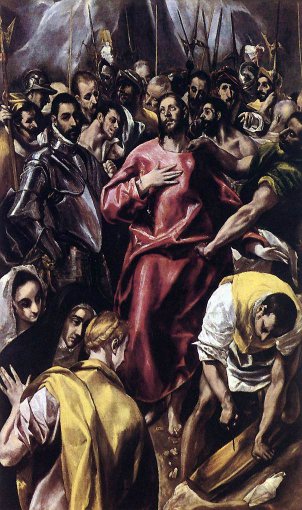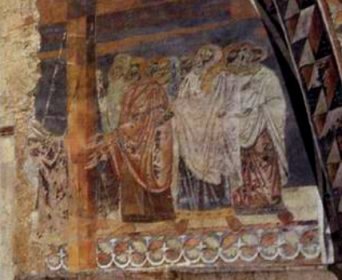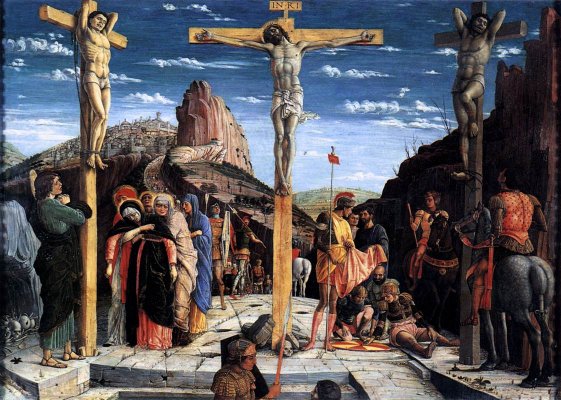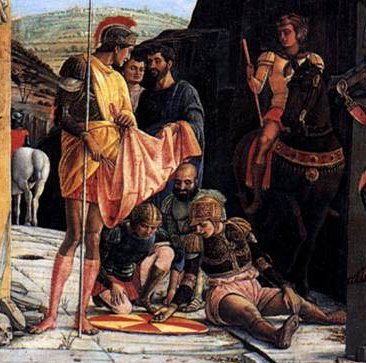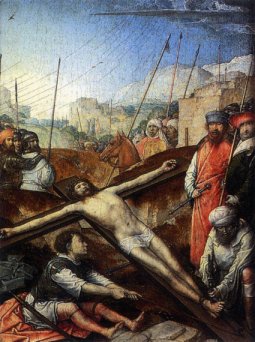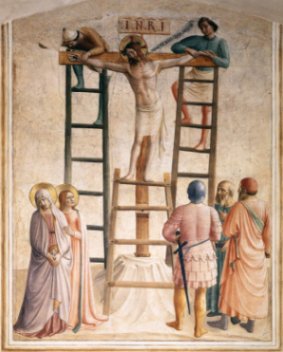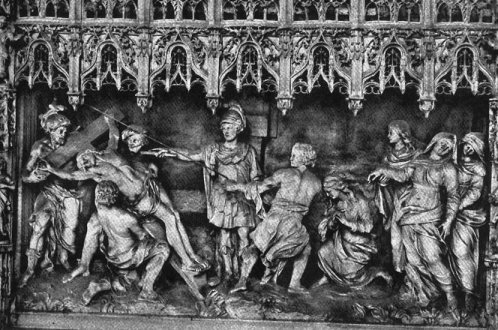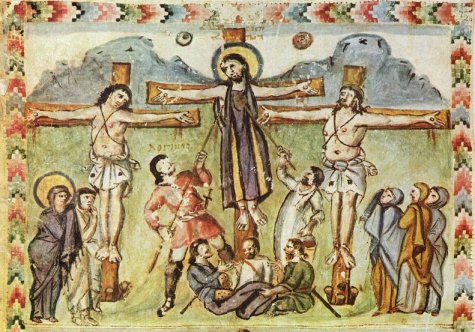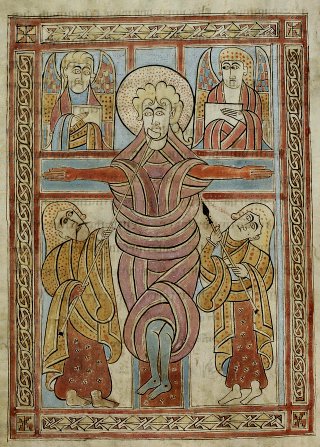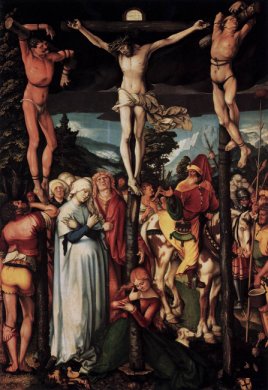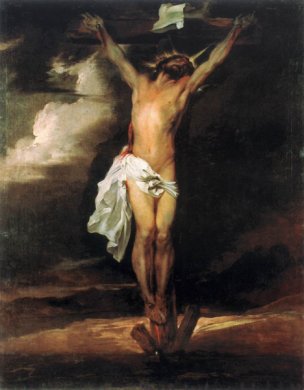|
The
Crucifixion |
|
|
As has become familiar by now, the gospels
agree on the main points of the narrative but disagree on the detail.
Again as usual, John's Gospel is the most radically different. It is also
the gospel most frequently referred to in art.
A key difference is in the timing of the event. In the Synoptics, the crucifixion
took place at the 'third hour of the day', i.e., nine o'clock
in the morning. John moves it on to the sixth hour, mid-day. To what extent the gospels can be regarded as historical narrative is a matter of controversy. It is perfectly reasonable to accept that Jesus Christ died, and did so in this manner. The details of the texts, though, weren't just there to tell a story. There was an imperative to validate the event in terms Old Testament prophecy. Here's how John tells the story: And they took Jesus, and led him away. And he bearing his cross went forth into a place called the place of a skull, which is called in the Hebrew Golgotha: Where they crucified him, and two other with him, on either side one, and Jesus in the midst. And Pilate wrote a title, and put it on the cross. And the writing was, JESUS OF NAZARETH THE KING OF THE JEWS. This title then read many of the Jews: for the place where Jesus was crucified was nigh to the city: and it was written in Hebrew, and Greek, and Latin. Then said the chief priests of the Jews to Pilate, Write not, The King of the Jews; but that he said, I am King of the Jews. Pilate answered, What I have written I have written. Then the soldiers, when they had crucified Jesus, took his garments, and made four parts, to every soldier a part; and also his coat: now the coat was without seam, woven from the top throughout. They said therefore among themselves, Let us not rend it, but cast lots for it, whose it shall be: that the scripture might be fulfilled, which saith, They parted my raiment among them, and for my vesture they did cast lots. These things therefore the soldiers did. Now there stood by the cross of Jesus his mother, and his mother's sister, Mary the wife of Cleophas, and Mary Magdalene. When Jesus therefore saw his mother, and the disciple standing by, whom he loved, he saith unto his mother, Woman, behold thy son! Then saith he to the disciple, Behold thy mother! And from that hour that disciple took her unto his own home. After this, Jesus knowing that all things were now accomplished, that the scripture might be fulfilled, saith, I thirst. Now there was set a vessel full of vinegar: and they filled a spunge with vinegar, and put it upon hyssop, and put it to his mouth. 30 When Jesus therefore had received the vinegar, he said, It is finished: and he bowed his head, and gave up the ghost. The Jews therefore, because it was the preparation, that the bodies should not remain upon the cross on the sabbath day, (for that sabbath day was an high day,) besought Pilate that their legs might be broken, and that they might be taken away. Then came the soldiers, and brake the legs of the first, and of the other which was crucified with him. But when they came to Jesus, and saw that he was dead already, they brake not his legs: But one of the soldiers with a spear pierced his side, and forthwith came there out blood and water. And he that saw it bare record, and his record is true: and he knoweth that he saith true, that ye might believe. For these things were done, that the scripture should be fulfilled, A bone of him shall not be broken. And again another scripture saith, They shall look on him whom they pierced. (John 19 16 - 37) |
|
|
The Disrobing of Christ Once again, John's story differs from the Synoptics. In the Synoptics, the garment are divided up, and the soldiers cast lots to decide who gets what. John adds the coat without seam, and this is what the lottery is for. This makes more sense; if the garment were divided, why would they need to cast lots? The reference to fulfilment of scripture refers to Psalm 22 verse 18. 'They part my garments among them, and cast lots upon my vesture'. Would the Roman soldiers really want to possess these clothes, or is this mentioned in order to include the reference to the Psalm? Psalm 22 is very much regarded as a prefiguring of the crucifixion. The gospels suggest that the garment were removed after the Crucifixion had begun, though this is not how it is portrayed in art; Christ is shown on the cross without clothes. El Greco's disrobing is happening before the crucifixion. The image on the right below is almost impossible to read; it is the disrobing of Christ by the Master of St Francis in the lower church, San Francesco, Assisi. I've included it because of the significance of this to the Franciscans - Francis, regarded as the second Christ, cast off his clothes and returned them to his father. |
|
|
|
|
| The detail of Mantegna's wonderful crucifixion on the right, below, shows the soldiers involved in the lottery for Christ's garments. I wonder how that board works? I couldn't resist including the whole painting as well. | |
|
|
|
|
Christ is nailed to the cross This part of the crucifixion procedure is not described in any of the gospels, which meant that artists had to work out how it happened themselves. Juan de Flandes (left) goes for the logical option of nailing Christ to the Cross before it was lifted; Fra Angelico (right) has Christ being nailed on the already lifted Cross, less practical but artistically more dramatic and powerful. |
|
|
|
|
|
The raising of the cross Another detail not referred to in the gospels, but on the basis that it must have happened it appears occasionally in art. This carving by Simon Maziére (1714) comes from the cathedral at Chartres. |
|
|
|
|
|
The vinegar and the the spear Although the two incidents did not happen at the same moment, they are sometimes portrayed as if they did, particularly in very early images. In Mark, Christ is given 'Wine mingled with Myrrh'; in Matthew it is 'vinegar mingled with gall' but in neither case does he drink it. In Luke it is vinegar, offered at part of the Mockery of Christ. John gives more detail; the vinegar and hyssop are given on a sponge, just before the death of Christ. Once again, this is a reference from a psalm: They gave me also gall for my meat; and in my thirst they gave me vinegar to drink' (Ps 69 v 21) The image on the right below is interesting for a
number of reasons. It is now in Switzerland, but is a manuscript of Irish
origin, dating from around 750. Here the position of the two soldiers is
reversed. (The wound is invariably shown on the right side of Christ
but that isn't going to happen here.) Notice also that the vinegar is
offered in a cup, not a sponge. Sponges simply hadn't been heard of in
eighth century Ireland. |
|
|
|
|
|
|
|
|
|
|
